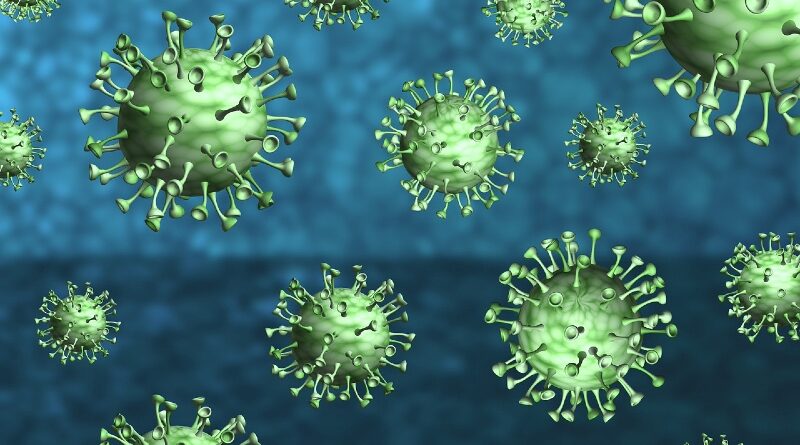Dallas County Reports 250 New COVID-19 Cases, Eight More Deaths
As Dallas County moves from the “Red” to the “Orange” COVID-19 risk level and local officials look warily toward the Labor Day weekend to see whether the recent trend of declining cases continues, here’s what you need to know today:
- Dallas County reports 250 new COVID-19 cases, eight more deaths;
- PCCI’s Vulnerability Index observes modest declines in Dallas County’s COVID-19 risk in August;
- Penn State reports potential complication in COVID-positive athletes.
Dallas County Reports 250 New COVID-19 Cases, Eight More Deaths
Dallas County Health and Human Services Thursday reported 250 additional confirmed cases of COVID-19, bringing the total confirmed case count in Dallas County to 72,860, as well as an additional eight deaths.
Of the 250 new cases reported Thursday, 122 came through the Texas Department of State Health Services’ (DSHS) electronic laboratory reporting (ELR) system and only one was prior to August.
The total number of probable cases in Dallas County is 3,026, including 10 probable deaths from COVID-19.
Among the deaths reported Thursday were a Duncanville man in his 50s, a Dallas woman in her 60s, a Garland man in his 60s, and a Garland woman in her 80s. Each had underlying health conditions.
Of the 934 total confirmed deaths reported to date, about 25% have been associated with long-term care facilities. Also among the deaths reported Thursday were two men in their 50s who lived in Dallas long-term care facilities, a woman in her 70s who lived at a Lancaster long-term care facility, and a man in his 80s who lived in a Dallas long-term care facility.

“The trends in Dallas County have been going well, and as a result, the color-coded risk chart moved for the first time from ‘Red’ high-risk to ‘Orange’ moderate-risk; however, as you can see from the eight deaths today and the numbers of new cases that we’ve seen this week, we are not where we need to be in our battle with COVID-19,” said Dallas County Judge Clay Jenkins Thursday. “In order to continue seeing the sort of gains that will get less people sick, get more businesses thriving, and more school children back in the classroom, we need to make smart decisions this Labor Day weekend. As you celebrate Labor Day, please do it responsibly. That means wearing a mask one hundred percent of the time when around people outside your household and maintaining six foot distancing. It also means frequent hand washing, avoiding unnecessary exposures, and should you have people over to your house or go to their house, wear your mask at all times when not eating or drinking. When you are eating and drinking, please ensure that you do that six feet away from people outside your family unit. If we all make smart decisions this weekend, we won’t see the sort of sharp rise in cases that we experienced after Memorial Day. It’s up to all of us flatten the curve and the best way to do that is to wear a mask and avoid unnecessary exposures.”
From Aug. 8-21, 393 school-aged children between 5 and 18 years of age were diagnosed with COVID-19 in Dallas County. About 50% of these cases were high school age. By zip code of residence, 203 (51%) of these children were projected to have been enrolled in Dallas ISD schools, and 2% in Highland Park ISD.
Of all confirmed cases requiring hospitalization to date, more than two-thirds have been under 65 years of age.
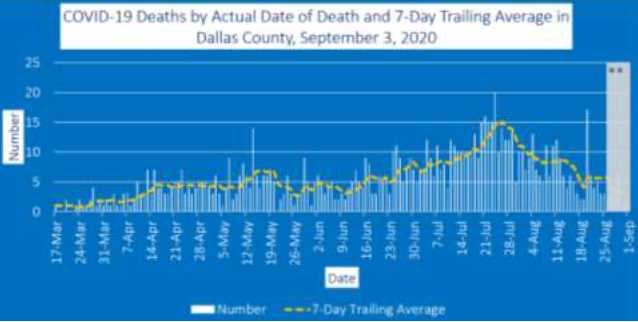
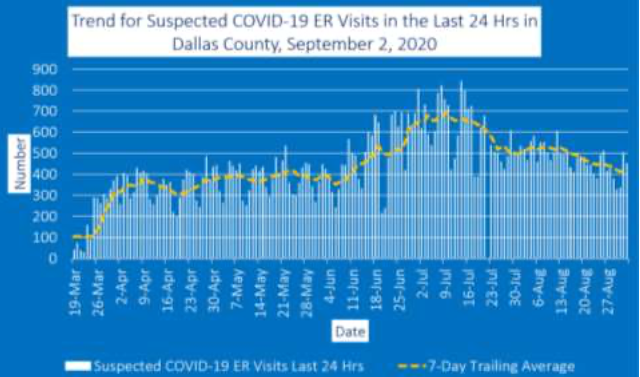
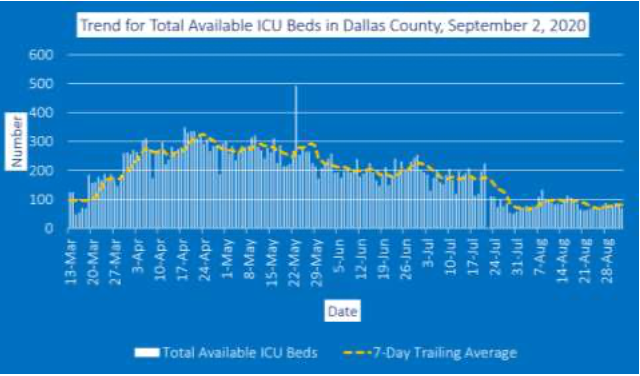
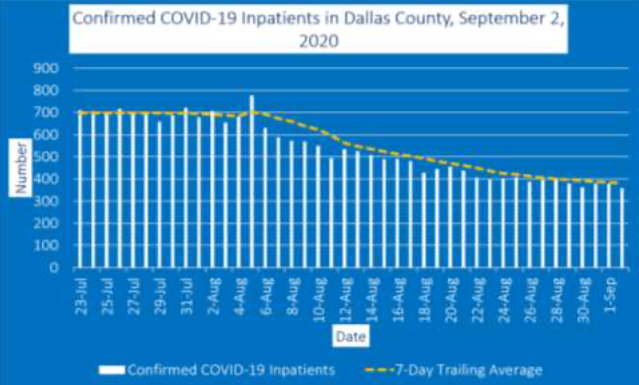
The county reported 359 COVID-19 patients in hospitals Wednesday. The number of emergency room visits for COVID-19 like symptoms in Dallas County was 454 Wednesday, which represents around 20% of all emergency department visits in the county according to information reported to the North Central Texas Trauma Regional Advisory Council.
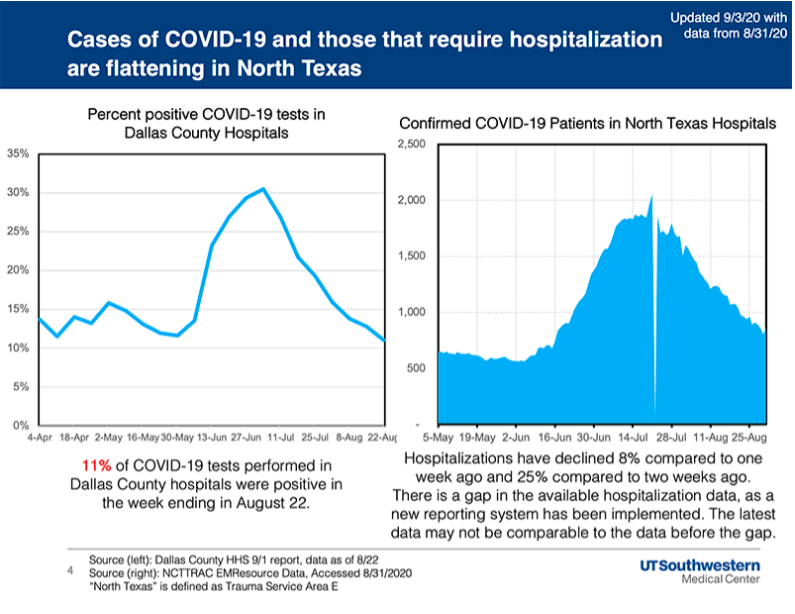
Hospitalizations in North Texas declined 8% compared to a week ago and 25% compared to two weeks ago, according to data from UT Southwestern Medical Center.
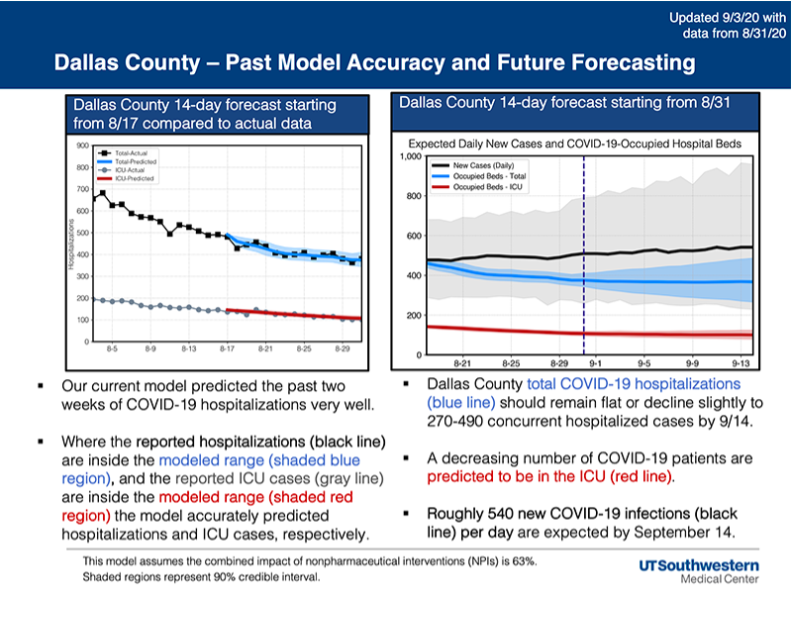
UTSW’s model projects total COVID-19 hospitalizations in Dallas County could remain flat or decline slightly to between 270 and 490 concurrent hospitalized cases by Sept. 14, and the county could see roughly 540 new COVID-19 cases per day by Sept. 14.
The percentage of respiratory specimens testing positive for the virus that causes COVID-19 continues to decline but remains high, the county says, with 11.3% of symptomatic patients presenting to area hospitals testing positive in week 34.
PCCI’s Vulnerability Index Shows Modest Declines in Dallas County’s COVID-19 Risk in August
Parkland Center of Clinical Innovations’ (PCCI) Vulnerability Index has noted a small, but important decline in COVID-19 risk for much of Dallas County between July and August.
Launched in June, PCCI’s Vulnerability Index determines communities at risk by examining comorbidity rates, including chronic illnesses such as hypertension, cancer, diabetes and heart disease; areas with high density of populations over the age of 65; and increased social deprivation, such as lack of access to food, medicine, employment, and transportation.
Based on tracking its key factors, including changes in confirmed COVID-19 cases and in mobility, the PCCI Vulnerability Index saw a modest decrease in the COVID-19 risk due to decreased COVID-19 cases across. However, several zip codes showed relative increases in their risk due to increased mobility compared to the same period in 2019 and a higher relative proportion of COVID-19 cases in their area compared to July.
The most at-risk ZIP code continues to be 75211, around Cockrell Hill. This area was the most at risk area for both July and August.
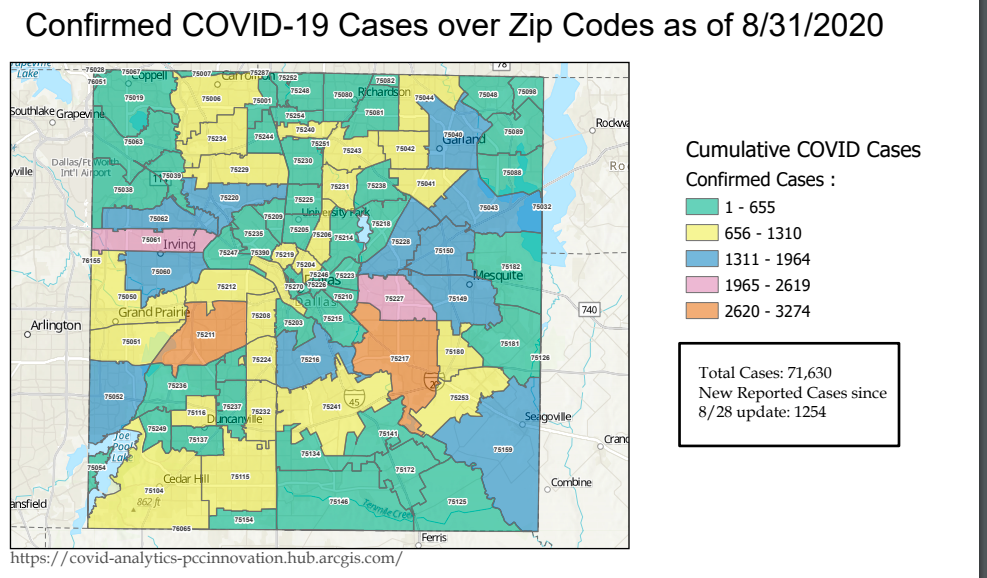
The ZIP code with the biggest jump in vulnerability to COVID-19 infection by the end of August was 75217, the region that includes Pleasant Grove, intersected by Loop 12 and U.S. Highway 175. This ZIP code jumped from 5.3% vulnerability rating to 93.5, making it one of the most vulnerable ZIP codes in Dallas County.
The ZIP code 75230, north of Walnut Hill Lane between U.S. Highway 75 and Dallas North Tollway, and 75218 immediately east of White Rock Lake, saw the largest drops in their vulnerability risk going from 45.6 to 12 and 38.9 to 16, respectively.
“The data offered by our vulnerability index is showing that Dallas County is taking incremental, but important steps in managing COVID-19 risks,” said Thomas Roderick, Ph.D., Senior Data and Applied Scientist at PCCI. “The changes we are witnessing are generally based on two important dynamic elements: recent confirmed COVID-19 cases, and mobility that includes people moving and gathering. For much of the county the number of confirmed COVID-19 cases began to slow in August, compared to July. With no holidays in August, there were fewer large gatherings and travel. These two factors can account for overall decrease across the county. Those areas experiencing increases in vulnerability ratings are largely attributed to yearly increases in mobility and to ongoing COVID-19 hotspots in a particular ZIP code.”
While August’s vulnerability index for Dallas County provides positive signs, Dr. Roderick warns that the Labor Day holiday, school openings, and sporting events may contribute to increases in vulnerability and COVID-19 cases. Additionally, he stresses the importance of personal behavior, such as wearing a mask, social distancing, and following the CDC guidelines.
Penn State Reports Potential Complication in COVID-positive Athletes
Just days before many area student athletes are due to begin their seasons (per UIL rules regarding when practices and games can start during the pandemic), Penn State health officials reported a potential complication found in COVID-positive football players.
The Washington Post reported that Penn State athletic medicine director Wayne Sebastianelli said that cardiac MRI scans revealed that roughly a third of Big Ten athletes who tested positive and were scanned appeared to have myocarditis.
Penn State officials later said that no Penn State athletes had tested positive so far, and that Sebastianelli was speaking of an as-yet unpublished study conducted by a colleague.
“When we looked at our covid-positive athletes, whether they were symptomatic or not, 30 to roughly 35 percent of their heart muscles [are] inflamed,” Sebastianelli said Monday. “And we really just don’t know what to do with it right now. It’s still very early in the infection. Some of that has led to the Pac-12 and the Big Ten’s decision to sort of put a hiatus on what’s happening.”
“What we have seen is when people have been studied with cardiac MRI scans — symptomatic and asymptomatic COVID infections — is a level of inflammation in cardiac muscle that just is alarming.”
Boston Red Sox pitcher Eduardo Rodriguez and Indiana offensive lineman Brady Feeney both experienced cardiac issues after being diagnosed with COVID-19.
Myocarditis can be especially dangerous for athletes, since the inflammation of the cardiac muscle can lead to arrhythmia, cardiac arrest, and even death, especially when someone rigorously exercises when they don’t know they have it.

